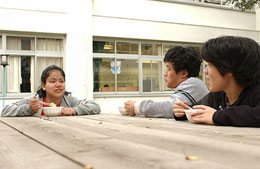The Komei School for the Physically
Handicapped is located in a two-story building in a quiet residential neighborhood
20 minutes by train from central Tokyo. There are a total of 818 schools for physically
or developmentally disabled children across Japan, and they are attended by approximately
80,000 students. The Komei School for the Physically Handicapped was founded in
1932 and is one of the oldest in the country. The school has 190 students ranging
in age from elementary school all the way to high school, and they commute via
school bus, family car, train, or by wheelchair.
 | |
| Students enjoy
talking with each other outside during break time. | |
The kids at the school have a variety of disabilities, including cerebral
palsy, muscular dystrophy, and chromosome abnormalities. There are also a number
of children with visual or hearing impairments. Inside the school, there are many
teachers and support staff for the students, and in addition to teaching lessons,
holding athletic meets, and taking the students on field trips, the teachers and
staff also assist the kids with everyday activities, such as eating lunch.
One
of the first things that a visitor to the school will notice is that students
can move around freely by themselves. The area is barrier-free; there are slopes
instead of steps and an elevator in place of stairs. Students can also enjoy relaxing
in a small area outside that has a bench, a large tree, and a garden.
| |
| There
are many teachers at Komei, so students can learn at their own pace. |
Students at Komei are grouped in classes according to the degree of
their disabilities. For example, the high school students are divided into five
groups, each of which takes lessons that suit the ability of the students. The
content of the lessons for each group is different, but the groups that use textbooks
study a basic curriculum not much different from that of other schools: Japanese,
mathematics, science, geography and history, English, music, art, and physical
education.
In the school's physical-training room, the kids work hard in
order to minimize their disabilities to the greatest extent possible and improve
their range of motion and physical health. This means strengthening not just their
muscles but also the rest of their bodies. Second-year high school student Sachie
Shima, who belongs to group five, undertakes one hour of physical training a week.
She explains, "I inflate a balloon to strengthen my lungs, and I get massages
on my body. It's tiring, but it's fun!"